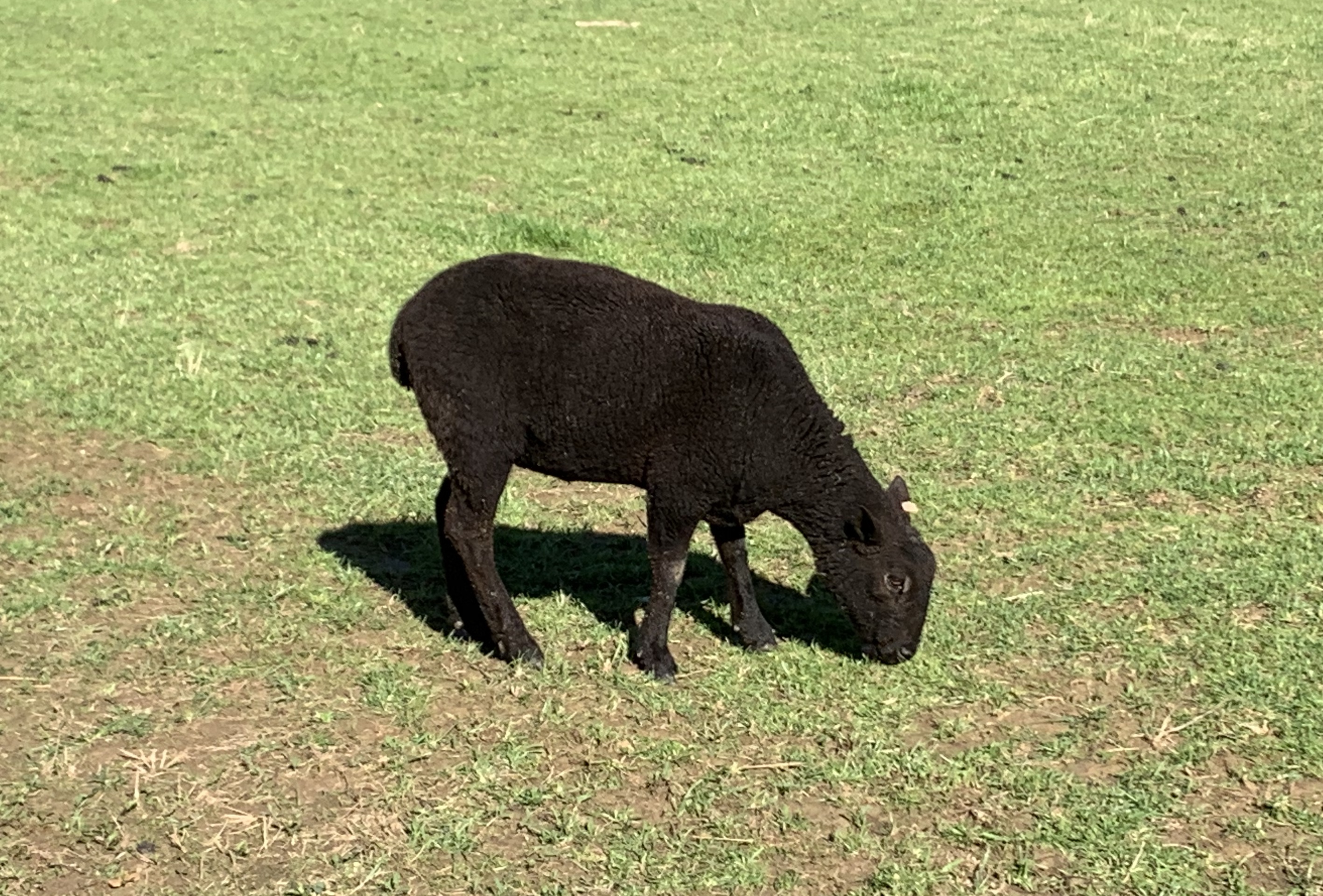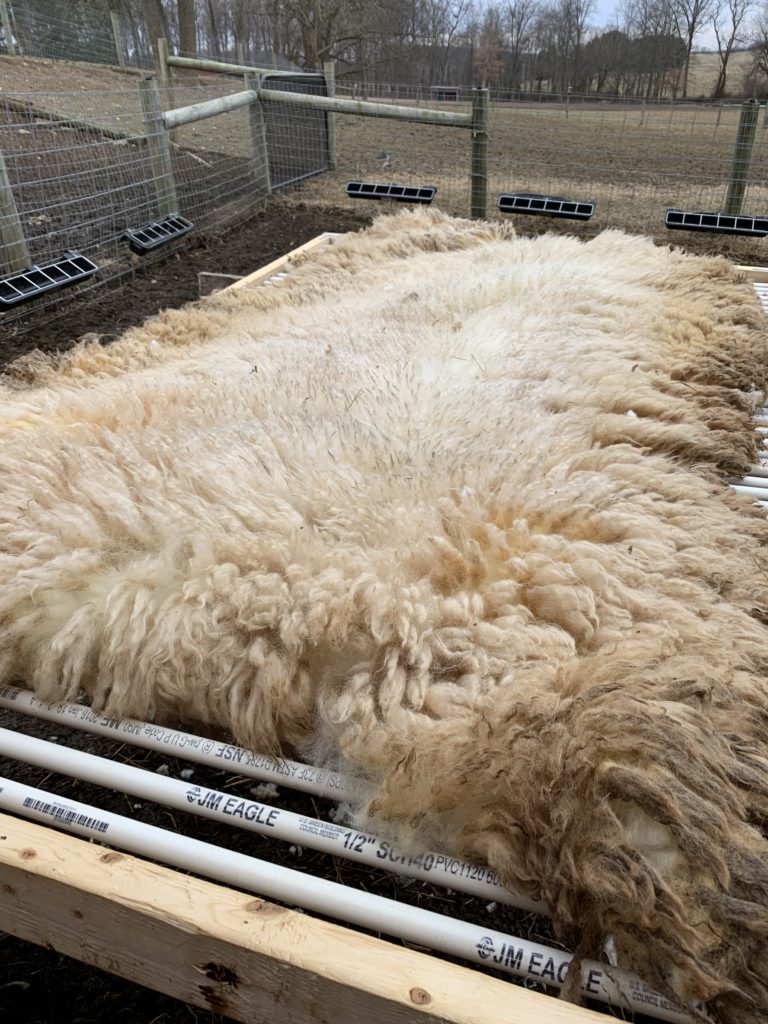
Some of the rams in our Fall 2023 lineup. Spot, the white ram in the front center, sports his trademark beauty spot. Spot was conceived in Fall 2020 via AI with semen imported from NZ, and will sire about 2/3 of our 2024 lambs. Knight, the natural colored (NC, “black”) ram in the right of the photo, sired about 2/3 of the lambs born in 2022. Buddy, the white yearling ram in the left of the photo, is still growing into his final size; he and James (the 4-year-old white ram in the rear; sire of half our flock, so has now been rehomed to a new flock) are both 100% Perendale, while Spot and Knight are 97% Perendale.
History: Our flock started with adult ewes that were mostly a cross between two breeds: Border Cheviots and Perendale sheep, while our rams are mostly purebred or very high % Perendales. Perendales are very rare in North America. Most or all such that we know of are descended from purebred Perendale sheep originally imported from New Zealand by Norlaine Schultz in Maryland before quarantine restrictions made it impossible to import live sheep. Before dispersing her flock, Norlaine sold Perendale breeding stock to flocks that included some in Maryland (Linda Tesdahl, Lazy Ewe Farm), Utah (a flock since dispersed), California (Marta Sullivan; flock now dispersed), and Jill Hackett (Ferndale Farms in Humboldt County, California), among others. Several U. S. breeders have continued to work on improving Perendale sheep in the United States and maintaining genetic diversity by importing semen from top rams in New Zealand. Since acquiring our original Perendale x Cheviot ewes, we have purchased additional high % Perendale sheep, allowing us to maintain two distinct maternal lines (details below). At Lucky Lane Farm, we are committed to educating shepherds about the advantages of this wonderful breed of sheep. Stop by to meet our sheep each year in the “Display of Breeds” barn at the Maryland Sheep and Wool Festival!
Perendale Sheep: Most often classified as “longwool” sheep, Perendale fleeces are much finer in texture than most longwool fleeces, being fine enough (in micron count) to sometimes qualify as “medium” fleeces; indeed, fleece judges differ in their classification, with some viewing them as “longwool” fleeces and others as “medium” fleeces.
Perendales originated in New Zealand as a cross between Border Cheviots and Romneys in hopes of improving farmers’ returns. Developed by Sir Geoffrey Peren at Massey University in 1956, who crossed a Cheviot ram over a Romney ewe, this breed enjoys considerable popularity in New Zealand. More information on their history and characteristics can be found here.
An “easy-care” dual-purpose (wool + meat) breed, Perendale sheep are easy lambers, excellent mothers, with good feet and good parasite resistance/resilience, highly productive sheep that thrive even on relatively poor pasture or hay, with a good temperament (neither too “flighty” nor too “stolid”; our rams are perfect gentlemen) – a perfect sheep for fiber enthusiasts and beginning shepherds alike. They are also well-suited to training Border collies, being able to stand up well to being extensively worked (if worked properly!) by dogs without turning “sour”. A Perendale sheep is not a random cross between a Cheviot and a Romney; many years of selective breeding went into the development of this breed.
Cora, a natural colored (NC, AKA “black”) yearling ewe. Most of our NC sheep lighten in color as they age, although Cora retained her dark color for several years.
Perendale sheep tolerate both harsh winters and warm, humid mid-Atlantic summers remarkably well. Their fleece is characterized by a 27-35 micron wool that attains a length of 5-7 inches, and a “handle” that makes their fleece appealing to handspinners. A ewe might yield 6 or more pounds of fleece (skirted), while an adult ram can yield 11 pounds (unskirted) or more of fleece.
We sell our fleeces each year at the Maryland Sheep and Wool Festival; we also market our fleeces at other local area fiber festivals, such as the Shenandoah Valley Fiber Festival. We also market our fleeces online. Our sheep are shorn in February, about a month before the ewes lamb. Please contact us if you wish to reserve fleeces. Our sheep are shorn professionally by an award-winning shearer, Emily Chamelin (2nd place finish in the Intermediate Division in the World Sheep Shearing Competition held in July 2019 in Le Dorat, France); you will find few “second cuts”. Our sheep are not coated, but the fleeces are still quite low in “vegetative material” (VM), because the ewes are maintained on pasture or are fed grass (not alfalfa) hay in feeders with small holes (not in overhead feeders). Our lambs typically graze our hayfield all winter long, requiring little if any supplemental hay, and are especially low in VM.
Fleece from Fergus, a 4-year-old 100% Perendale ram, at shearing. Fergus possessed fleece superpowers; this fleece weighed 11 lb unskirted at shearing.
Our Objectives: We have been working towards establishing a pure Perendale flock on our farm, both by “breeding up” (with each generation being a higher percentage pure Perendale) and by acquiring pure Perendale ewes. In the fall of 2017, we purchased two high % Perendale ewe lambs (both natural colored; NC) and one NC high % Perendale ram lamb from Linda Tesdahl, all conceived via artificial insemination using semen imported from New Zealand. In the fall of 2018, we were fortunate to be able to purchase ten older pure or high % Perendale ewes from Jill Hackett of Ferndale Farms in Humboldt County, California, all originally bred by Marta Sullivan. This expanded our “gene pool” for our foundation ewes to twelve pure or high % Perendale ewes in two maternal lines (one originating from Marta Sullivan, the second from Linda Tesdahl). At this point (2024), the Perendale ewes in our breeding group of 27 ewes average 96% pure (range = 88-100%).

We re-established the Perendale registry in North America previously managed by Marta Sullivan in 2020; the website for Perendales in North America is located at: https://perendale.org/ . All of our Perendales are now registered. We are holding registration fees low ($5) to encourage individuals to register their sheep. We are committed to increasing the genetic diversity of this breed in North America by importing semen from top rams in New Zealand. We currently have an agreement with a top Perendale breeder in NZ whose flock emphasizes good growth and excellent parasite resistance, without sacrificing fleece quality. We should have extra straws to sell from two such rams in Fall 2024 for breeding. Contact us for more information!

Our breeding objectives include the following: (1) Parasite resistance/resilience (determined by need to deworm, as dictated by FAMACHA score plus fecal egg counts on potential replacement rams, as determined during the prime mid-summer parasite season); (2) fleece quality; (3) maternal productivity (defined by cumulative adjusted 60-day weaning weights, added over a 2-year period); and (4) prolificacy (we aim towards twin lambs, or triplets if raised without supplementation). We only deworm lambs as needed, and rarely if ever need to deworm adult sheep. The first three of these are highly heritable traits.

We sell our ewe lambs in mid-summer, ram lambs (for breeding and/or freezer lambs) in early fall; we also typically have yearling ewes (and occasionally rams) available in mid-summer. If demand exists, we will keep adult ewes until ~ December to be sold as exposed ewes, at an additional cost. Please contact us (ideally prior to March) if you want to be added to our mailing list for freezer lambs or breeding stock, as we sell out each year.

Five-month old Perendale ram lambs: Fergus (rear), James’ father, and Tup (foreground)
Freezer Lambs: Ram lambs will average roughly 120 lb when they go to market; “hanging weight” (after slaughter, but including bones) is about half of that. We sell either whole or half lambs for consumption. If you don’t have room for a whole lamb (typ. 50-60 lb of meat) in your freezer, consider splitting a lamb with a friend. By buying a whole lamb, you get to control how each half is cut – lamb chops vs rack of lamb, lamb shanks vs ground lamb, butterflied legs vs whole or half legs, shoulder roasts vs chops or cubes for stew or shish kebabs, and so forth. You also save considerably over the cost of buying individual cuts. We are happy to walk you through the process of deciding how to put together a cutting order!



